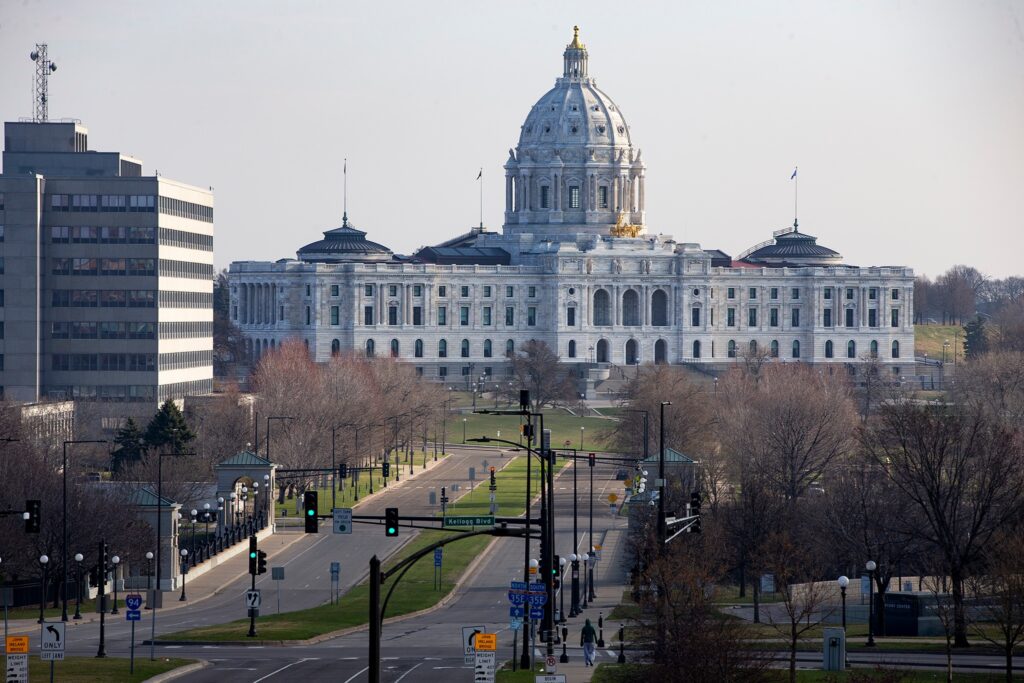Minnesota Capitol. Courtesy of Minnesota House Information Services.
While most people are paying close attention to the presidential race, the contests that will have a more immediate impact on Minnesotans — from education, transportation and human services funding to legal sports betting — are 134 state House districts on the ballot this year. About 15 close races will determine whether Republicans return us to divided government, or Democrats keep their trifecta.
But those House races and the presidential race are closely related.
Here’s how:
The margin of the winning presidential candidate — rather than the absolute vote percentages or vote margins — seems to be key in determining which party controls the Minnesota House.
Below is a chart showing the election results for the Democratic presidential candidate’s margins ranked from highest to lowest and the outcome of Minnesota state House seats won by the Democratic-Farmer-Labor Party.
Note the correlation between the Democratic presidential percentage margin over the Republican candidate and the number of House seats won by the DFL.
When the Democratic presidential nominee does well, so do DFL state House candidates.
This sounds pretty intuitive, but let’s try to figure out the key number — how much does Vice President Kamala Harris need to win by in Minnesota if the House is to remain in DFL hands?
When the Democratic presidential candidate’s margin was 4% or greater over their Republican opponent in eight elections —1976, 1980, 1988, 1992, 1996, 2008, 2012 and 2020 — the DFL has won control of the state House with 70 or more seats.
When the Democratic presidential candidate’s percentage margin was below 4% over the Republican candidate in four elections —1984, 2000, 2004 and 2016 — the Republicans have won control of the state House.
There are only 12 elections for this analysis – not enough data to make any scientific findings or establish a valid regression analysis.
But the correlation is there regardless.
Is there a Klobuchar effect?
We should also consider the impact that a U.S. Senate candidate can have on state House elections.
We looked at the U.S. Senate seats up for election in presidential election years to see if there was any relationship between those races and the number of House seats won by the DFL. The elections are listed in order of the highest percentage margin of the DFL Senate candidate (HHH in 1976) to the lowest (Growe in 1984) and the resulting state House seats won by the DFL in each election.
There appears to be very little, if any, relationship between how the DFL U.S. Senate candidate has performed and the number of House seats won by the DFL. For example, the DFL won 81 seats in the State House in 1988 in an election that Skip Humphrey lost to David Durenberger by 15%; and when Al Franken won an election over Norm Coleman by a few hundred votes or 0%, the DFL won 87 State House seats. which means Democrats shouldn’t expect too much coattail effect from Sen. Amy Klobuchar’s expected lopsided victory this year.
There has been speculation of a “Klobuchar effect” on state House seats in the 2024 race. Klobuchar has won with big margins: 20% in 2006, 35% in 2012 and 24% in 2018. Despite DFL hopes, any Klobuchar effect appears to be small. In 2012 when Barack Obama won by 7.7% the House DFL won 73 seats and Klobuchar won by a 35% margin. In 2020, Biden won the state with a 7.5% margin (about the same as Obama in 2012), Sen. Smith won by 5.2% and the House DFL controlled 70 seats. As you can see, very little difference, despite Klobuchar’s far bigger margin of victory in 2012.
Mondale and Walz effect — the top of the ballot effect on the Minnesota House
Another factor to consider: A Minnesotan on the national ticket.
It’s unclear what impact a vice presidential nominee has on his or her home state electoral outcome; the academic literature is mixed. There may be a vice presidential bonus in elections, and while small, that could be meaningful given how close the 2024 presidential election appears to be.
All seven battleground states are roughly even in the polls; the candidates are expected to spend $300 million in Pennsylvania alone. Even a small vice presidential bonus may matter to our state House elections. For example, in Minnesota every 1% margin of votes in a presidential race translates into approximately 225 votes in a Minnesota state House district. That is a significant number — four to six House seats are decided in each election within that range.
Polarization drives more recent elections
The pattern discussed here covered nearly a half century of voting in Minnesota presidential elections. A lot has changed in that time. The thought of the Minnesota state House having 104 members of the same political party at one time — as in 1976 — would be considered fantastical or even delusional these days. Even achieving 80 House seats appears to be remote if not impossible as the partisan divide is exceptionally great.
What hasn’t changed, however, is that Minnesota has voted for the Democratic candidate for president in every election since 1976. The last three presidential elections (2012, 2016 and 2020) have seen a stark realignment of seats in the Minnesota House. Rural Democratic seats have disappeared, while suburban Democratic seats have multiplied in equal numbers. It may well be that the hardening of political views has also hardened the movability of legislative seats.
Elections are always a mirror of the voters. You will hear a lot of noise about the election over the next few days. If you are serious about elections, pay attention to this signal and the relationship between the percentage margin between Kamala Harris and Donald Trump if you want to figure which party wins control of the Minnesota House of Representatives on Tuesday, November 5th.

